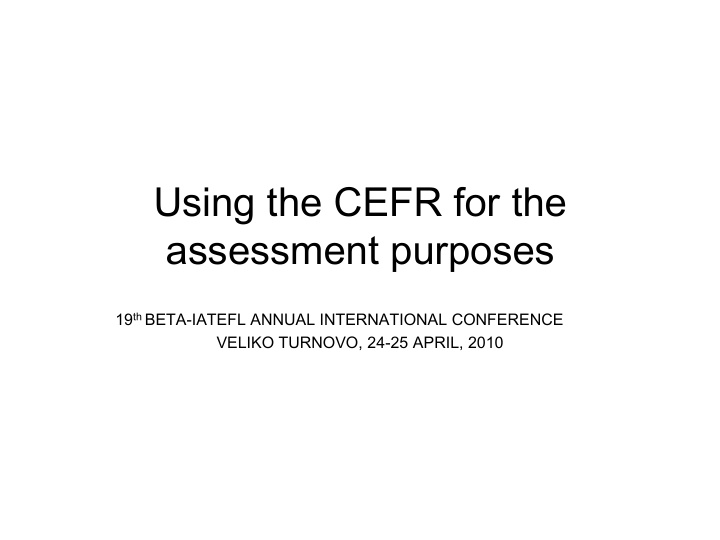



Using the CEFR for the assessment purposes 19 th BETA-IATEFL ANNUAL INTERNATIONAL CONFERENCE VELIKO TURNOVO, 24-25 APRIL, 2010
Desislava Dimitrova, Dimitar Atanasov ddimitrova@nbu.bg datanasov@nbu.bg New Bulgarian University www.evaluation.nbu.bg
Steps in test development process o Development o Test production process o Live exam o Analysis and review
Development: chain of decisions “Primary use of an assessment is to gather information to help us make decisions that will lead to beneficial consequences for stake holders.” (Bachman, 2010) Test development process begins with the understanding of consequences, decisions and interpretations about the test taker’s language ability.
Example: chain of decisions (1) o It will be a test for foreigners who do not live in Bulgaria, but they learn the Bulgarian language for some reasons. o The test score will be used from test takers to understand their own progress in learning, and to give them a reasonable language profile with weaknesses and strengths. o The test score will be used from the teacher for course design.
Example: chain of decisions (2) o The test score will be interpreting on terms of communicative language competence and the interpretation framework will be criterion reference, following the scale and descriptors of CERF.
Development: interpretation of test taker’s language ability (1) o In terms of competence: a profile of communicative language competence, language activities and domains from the descriptive scheme of the CERF o In terms of criterion level: The Common Reference Levels of CERF as common standards.
Development: interpretation of test taker’s language ability (2) • The first problem is a decision of which one is a measurable element in the construct of language ability, which one is an assessment criteria and which one is the task in language test. • The second problem is a decision of how many language tasks are enough for the true interpretation of the test taker’s language ability.
Example: interpretation of test taker’s language ability (1) We need: o to make a profile of communicative language ability o to give feedback about strengths and weaknesses o to gather information in an appropriate way o to collect evidences
Example: interpretation of test taker’s language ability (2) We claim: o to undertake the principle of cognitive diagnosis assessment (CDA ) for creating a language profile of the test takers.
Why cognitive diagnosis assessment (CDA) CDA is designed to: o measure specific knowledge structures and processing skills in students o so as to provide information about their cognitive strengths and weaknesses.
Main features of CDA o Q-matrix (a set of attributes): Attributes are specific skills, knowledge, competencies, mental processes, and strategies that examinees should master or possess to answer an item correctly. o Cognitively diagnostic psychometric model: Psychometric modeling of these attributes and items.
Example: Q-matrix on the basis of CERF (1) At first we have chosen the elements of linguistic and pragmatic language competence. o We define 6 attributes, following the CERF description. o 6 (cognitive) attributes were intended to be important for test performance. o Mapping the attribute to the items is made by logical inference.
Example: Q-matrix on the basis of CERF (2) Then we have chosen the language activities, from the list of CERF, interpreting them as a product of language use. Finally we have chosen the evidence for each language activity, interpreting them as assessment criteria. At this stage we make the tests’ task design in connection of language activities from CERF.
Example: Q-matrix on the basis of CERF (3) Cognitive Kind of Language Evidences of Tests’ language activity as a performance attribute task product (Assessment activity criteria) Understanding Vocabulary Listening reception LC1+LC3 range instruction A General range
Analysis and review (1) Two steps are needed to make conclusions about test takers language profile, based on the principle of CDA. o We need to verify the content of Q-matrix: if the identified attribute are the same attributes, that examinees should master or possess to answer an item correctly. o We need to apply a statistical method for estimating a set of attribute (or skill) mastery patterns based on an examinee’s responses to test items.
Analysis and review (2) o In our work we apply the model, developed by D. Dimitrov and D. Atanasov. A demo version of this statistical package is available on the web-site of Assessment Centre, NBU. o We run statistical analysis for 34 items of the test, which tests listening, grammar and reading for orientation.
1. When the attributes are not enough to perform the item correctly.
2. When the number of attributes is more than the examinee needs to perform the item correctly.
3. When the attributes are enough for successful item performance.
4. The attributes (1) • 1 LC1: knowledge of, and ability to use, the vocabulary of a language, consists of lexical elements and grammatical elements. • 2 LC2: knowledge of, and ability to use, the grammatical resources of a language. • 3 LC3: a knowledge of, and skill in the perception and production of the sound-units (phonemes) of the language and their realisation in particular contexts. • 4 LC4: knowledge of and skill in the perception and production of the symbols of which written texts are composed. • 5 PK1: is the ability of a user/learner to arrange sentences in sequence so as to produce coherent stretches of language. • 6 PK2: the use of spoken discourse and written texts in communication for particular purpose.
4. The attributes (2)
Conclusions We need a finer structure of description. The CERF gives us this point of view. Identify the various components of communicative competence as group of knowledge, group of understanding and group of applying.
Recommend
More recommend